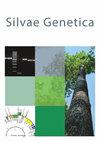Origin and genetic nature of polyploidy in paleoendemic coast redwood (Sequoia sempervirens (D. Don) Endl.)
IF 1
4区 农林科学
Q3 FORESTRY
引用次数: 0
Abstract
Abstract It is not known when the polyploid coast redwood (Sequoia sempervirens) evolved from its diploid ancestors, and what is its type of polyploidy. Whether close relatives of Sequoia, giant sequoia (Sequoiadendron giganteum) and dawn redwood (Metasequoia glyptostroboides), have possibly contributed to the ancestry of hexaploid of Sequoia remains an open question. The nature of hexaploidy in Sequoia has baffled biologists for more than a century. Based on the chromosome configurations in Sequoia, G. Ledyard Stebbins was the first geneticists who postulated in 1948 that Sequoia is an autoallohexaploid (AAAABB), and an ancient species of Metasequoia might have been one of the putative ancestors of Sequoia. After its chromosome number (2n=6x=66) was confirmed in hexaploid Sequoia, the type of polyploidy in Sequoia has been further investigated for the past 70 years by a number of investigators, using cytogenetic and genetic data. Although an autoallohexaploid (AAAABB) origin of Sequoia has remained one of the dominant hypotheses until recently, an alternative hypothesis, amongst other possible origins, was also put forth by Ahuja and Neale (2002), that Sequoia may be partially diploidized autohexaploid (AAAAAA), derived from some ancestral species of Sequoia, thus carrying a single ancestral genome. Cytogenetic, molecular genetics, and genome sequence data now support the hypothesis that Sequoia originated as an autohexaploid.古特有海岸红木(Sequoia sempervirens (D. Don) Endl.)多倍体的起源和遗传性质
多倍体海岸红木(Sequoia sempervirens)从其二倍体祖先进化而来的时间和多倍体类型尚不清楚。红杉的近亲巨红杉(Sequoiadendron giganteum)和赤杉(Metasequoia glyptostroboides)是否可能对红杉六倍体的祖先有贡献仍然是一个悬而未决的问题。红杉六倍体的本质困扰了生物学家一个多世纪。1948年,遗传学家G. Ledyard Stebbins根据红杉的染色体结构,首次提出红杉是一种自异体六倍体(AAAABB),并推测一个古老的水杉种可能是红杉的祖先之一。在六倍体红杉的染色体数目(2n=6x=66)被确认后,70年来,许多研究者利用细胞遗传学和遗传学资料对红杉的多倍体类型进行了进一步的研究。尽管直到最近,红杉的自异体六倍体(AAAABB)起源一直是主流假说之一,但Ahuja和Neale(2002)在其他可能的起源中也提出了另一种假说,即红杉可能是部分二倍化的自异体六倍体(AAAAAA),源自红杉的某些祖先物种,因此携带单一祖先基因组。细胞遗传学、分子遗传学和基因组序列数据现在支持红杉起源于自六倍体的假设。
本文章由计算机程序翻译,如有差异,请以英文原文为准。
求助全文
约1分钟内获得全文
求助全文
来源期刊

Silvae Genetica
农林科学-林学
CiteScore
2.20
自引率
10.00%
发文量
10
审稿时长
3 months
期刊介绍:
Silvae Genetica is an international peer reviewed journal with more than 65 year tradition and experience in all fields of theoretical and applied Forest Genetics and Tree breeding. It continues "Zeitschrift für Forstgenetik und Forstpflanzenzüchtung" (Journal of Forest Genetics and Forest Tree Breeding) founded by W. LANGNER in 1951.
 求助内容:
求助内容: 应助结果提醒方式:
应助结果提醒方式:


